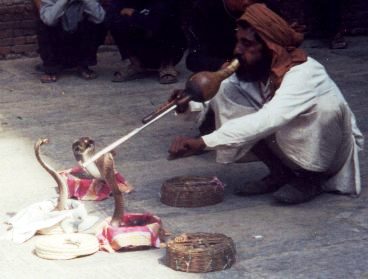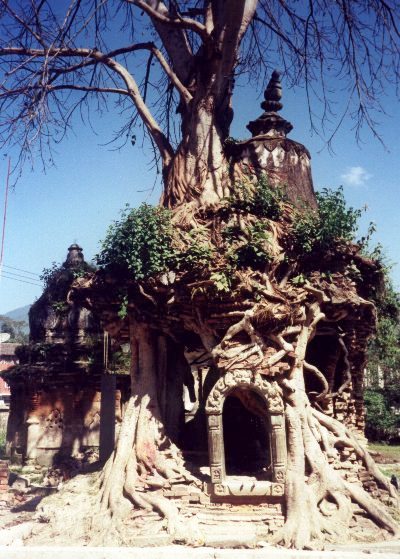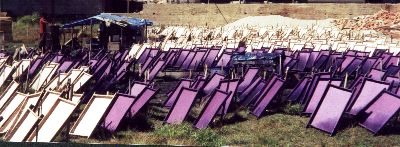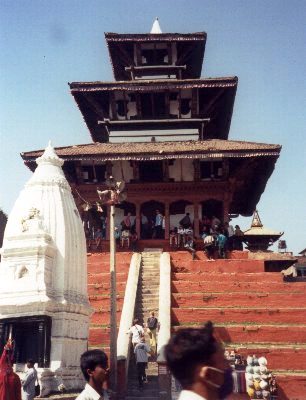|
Saturday, October 14, 2000 Kathmandu
The next few days we took hikes in the Kathmandu valley and up into the surrounding hills. This was to keep us hiking, gain some acclimatization on the hills and to get out of the rather polluted atmosphere of the city. The first day's hike sure was easier coming down than going up. I attributed all my huffing and puffing to the fact I had started the trip with a cold and the fact we were still not on Nepali time. At least that's my excuse. Maybe it was the first hour of our hike through the city streets until we reached the gates of the Nagarjun Forest Reserve. We paid our admission fee and were shown the beginning of the trail that led straight uphill to a temple at the top of a distant peak. My walking pace kept slowing down and the breaks became more frequent. Thank goodness for the forest shade as the day was sunny and warm. We never did reach the temple. Our excuse was that we were running out of water and we had to be back at the Guest House to meet Derek & Josie at 12:30. We did manage to climb 1500 ft to an altitude of approx 6000 ft and we did have a good view of over the valley. It was a good walk anyway. Good timing. Derek & Josie arrived at the Guest House just before we did, so we heard all about their peaceful few days in Nagarkot, a hillside resort at the eastern e dge of the Kathmandu valley. In the afternoon we all took a taxi to visit Swayambhunath, the Monkey temple. It is one of Nepal's World Heritage sites and as the name implies, there are lots of monkeys wandering around the collection of Buddhist Stupas an d Hindu temples. The site is reached by climbing a very long set of steep steps, but the reward is a good view of Kathmandu below. By the way, for those of you who don't know, a Stupa is a Buddhist religious domed shaped structure with the Nepal eyes pai nted on all four sides watching out for you and topped by a spire from which washing lines of coloured prayer flags radiate down from the top. The flags flutter in the breeze, sending the prayers printed on them to the heavens where they are returned to protect those on earth.
Eventually, even the road petered out and we followed a path through a pine forest. The resulting shade was a welcome relief from the heat of the valley. Our goal was a Hindu temple outside the village of Gorkana and we did find it. The courtyard surrounding the 3 tiered temple was filled with a large collection of stone statues of Hindu deities. Several priests were reciting their prayers and one of them concluded his by launching a banana leaf boat, filled with marigold petals and incense sticks, on the adjacent river, where it swiftly disappeared in the current. An old man pointed out the ruin of small earlier temple, completely overgrown with the roots of a Banyan tree.
We had hurried back to Kathmandu expecting to meet another member of our trekking group, Steven, who was arriving from Australia via Singapore, only to get a message that he was delayed until Tuesday noon, so we just vegged happily in the garden for the afternoon. Tuesday morning we put in our last training walk before the rest of our trekking group arrived. Ray & I took a taxi straight north of the city to the village of Budhanilkantha. The village is a bustling market town that serves the locals and the many worshippers who come to visit the Jalasan Narayan temple with the la r gest reclining image of Vishnu in the world. We were headed for a walk up into the hills first, so we negotiated with our taxi driver to wait for us to return in twohours and set off up a steep road which ended a half hour later at the gates of the Shivapuri Watershed and Wildlife Reserve. At this point we attracted a gang of 6 young boys all wanting to provide guiding services to the Gompa (Buddhist monastery) on a hilltop in the Reserve. We politely refused their offers, paid our entry fees and signed in with the soldiers who patrol the reserve. The soldiers tried to get rid of the "guides" for us but threeof them got past and ran ahead to wait for us. We then had company on our walk, whether we wanted it or not. Nothing would dissuade them, even me getting angry, so we gave up and ignored them as best we could. The road, now dirt and rutted and full of switchbacks, continued at the edge of a forest and up the hills. It was hot walking, but we had enough water with us and at least I was no longer winded as I was the first day. About half way up we came to another check point and were joined by three monks walking up to visit a friend in the Gompa. They told us there were actually twoGompas, one for nuns and the other for monks. We never did reach either as time, once again, was marching on and we had to get back to town. We had good views of the valley from several spots along the way, including a long cloud of smog hovering over the city in the distance. Apparently Kathmandu has similar topography as LA: a valley surrounded by hills that hold in the fumes of the motorcycles, tuk tuks and cars. We returned down the hill quickly, stopping on the way to photograph laundry lines of Pashmina scarves that had just been woven on hand looms in an adjacent buildi ng. These soft, light cashmere type scarves are a hot sales item in Kathmandu now and cost 200-300 dollars in Holt Renfrews back home. Our driver was waiting for us on our return, patiently polishing his car, and was quite willing to wait longer while we visited the temple. Before we got inside we were again offered guiding services by a teenaged boy. We refused, of course, but he came along anyway and did explain the significance of quite a few of the Hindu images. The sleeping Vishnu was an 11th C stone image reclining on a bed of protective snakes, in the middle of a small pond. Two young boys, who are priests, were performing ceremonies over the cloth draped Vishnu while a large number of worshippers, mostly women dressed in red saris, made offerings and prayers. The legend is that Vishnu sleeps for 4 months, beginning with the monsoons and ending in early November, at which time thousands of pilgrims arrive to pay homage. I think I will give that day a miss. The young boy told me that one of the deities in the temple ensures that women have a long and divorce-free marriage, so that may explain the number of women present. Back in Kathmandu, we had lunch and waited to greet Steven when he arrived in the early afternoon. His delay was caused by aheart attack suffered by Steven's seatmate on the flight from Sydney to Singapore. Two hours into the flight, the plane turned around and the man was whisked off to the hospital; successfully, I heard. The plane then took off again but by that time the connecting flights were missed. Instead, Steven flew to Bangkok, was put up overnight with enough cash to bankroll a night on the town, and flew to Kathmandu the next day. Maybe he should be giving lessons on air travel. The other members of our trek group arrived without incident. Our friend Bob Dwyer & his friend Les arrived from Bangkok at suppertime & the others arrived from Hong Kong later that evening.
This afternoon was the 'weighing in' ritual. We were given down sleeping bags that are fitted into our already full Everest Trekking bags, and then the whole thing was weighed. Everyone was having trouble adhering to the 15 Kg limit and there was much removing of not quite essential items. The weight limit exists because our porters have to carry 2 of these bags, plus whatever personal gear they take along. This is a heavy load. Next, Ray, our intrepid group leader, and Tashi and Nancy, the Nepali partners for Everest Trekking, gave us all the low down on what to expect on our trip and how to avoid getting ill, and finally we were free for our last night in town before the trek tomorrow. We fly in the morning to Pokhara, the center for the Annapurna region, take a 45 minute bus ride and start walking uphill to our first campsite. We are all looking forward eagerly to hiking in the high mountain ranges for the next 2 weeks. That means I will be out of Internet range until our return on November 2, so expect an account of our experiences sometime after that. I'm off to our first group dinner now and Pam has informed us that we all have to go to the New Orleans restaurant and bar for a little celebrating after supper. Life is tough. |
 Our first full day in Kathmandu was spent
reacquainting ourselves with the narrow, bustling streets
leading up to Durbar Square, the site of many temples,
eager guides, beggars and many salespeople. In one of the
Our first full day in Kathmandu was spent
reacquainting ourselves with the narrow, bustling streets
leading up to Durbar Square, the site of many temples,
eager guides, beggars and many salespeople. In one of the

 On our way back to Kathmandu, we stopped
to take pictures of a paper making operation set up in a
roadside field. One man fed strips of old cloth into a
boiling vat made from an oil
On our way back to Kathmandu, we stopped
to take pictures of a paper making operation set up in a
roadside field. One man fed strips of old cloth into a
boiling vat made from an oil 